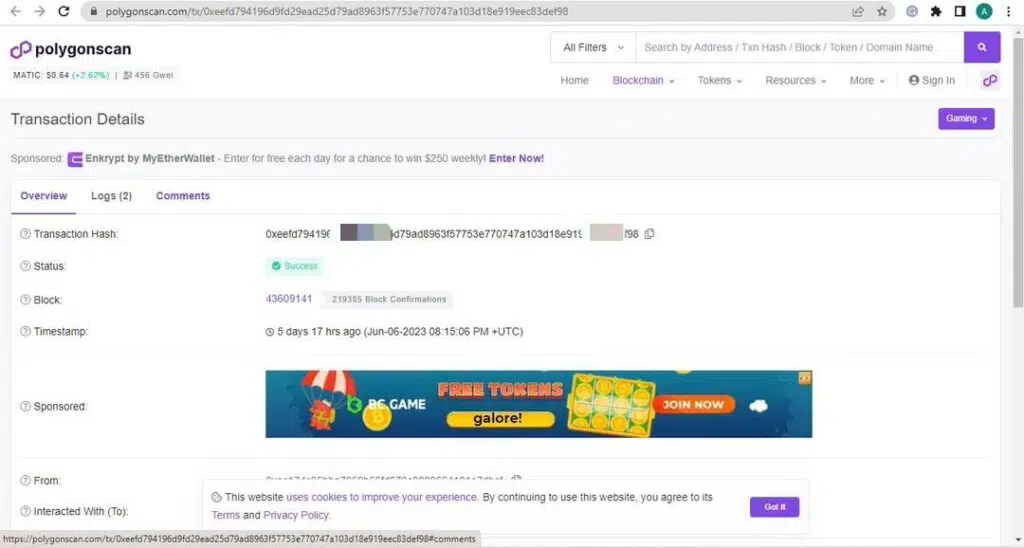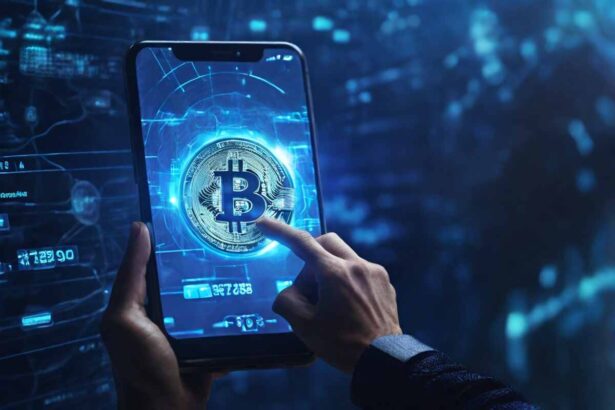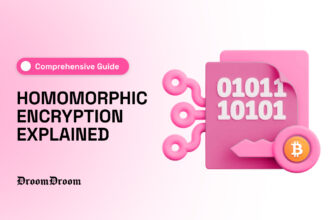The existence of cryptocurrencies relies on several components, including the blockchain, which is regarded as a major backbone. Blockchains are basically strings of blocks attached in a chain-like form, with each block holding details about a transaction.
- Detailed Breakdown of Block confirmation
- Why Multiple Block Confirmations Are Important
- Who Determines The Number of Confirmations
- Factors That Influence Block Confirmation
- How Long Does Block Confirmation Take
- How to Speed Block Confirmation
- How To Check a Block Confirmation?
- What Are Block Explorers
- Conclusion
Block confirmation is a way to validate that transactions added onto the blockchain are legit and executed correctly to avoid issues such as double-spending. Block confirmation is similar to transaction receipts received after successfully transferring funds from one account to another.
The process of blockchain confirmation is more intricate than defined by the above analogy.
Detailed Breakdown of Block confirmation
Transactions on the blockchain involve different parties and several processes. At the core are the nodes/miners tasked with verifying these transactions and adding to the blockchain. When a crypto transaction is initiated on the blockchain, miners on the blockchain network are needed to verify whether this transaction is legitimate.
Verifying a transaction depends on the type of consensus mechanism the blockchain uses. A consensus mechanism refers to how miners of a blockchain network will come to an agreement on how to confirm that a transaction is valid.
There are two predominant types of consensus mechanisms: the proof of stake (PoS) and the proof of work (PoW). Blockchains, such as Bitcoin, Ethereum Classic, Dogecoin, and Litecoin, rely on the PoW that requires miners to solve complex mathematical problems. Whichever miner solves the problem will be responsible for verifying the transaction. Cryptocurrencies like Ethereum, Cardano, Solana, and Polkadot, on the other hand, rely on PoS that mandate miners to stake their tokens and would randomly choose from the pool of miners to verify a transaction.
Every block has a capacity for how much transaction data can be stored in it. For example, if a block size is 8 MB, until details of transactions up to the limit are stored, the block won’t be added to the blockchain. Once filled and added to the blockchain, the transaction becomes immutable and secured; the block is confirmed.
The miners get incentized to participate in the process by receiving a fraction of the transaction fees from users. This complements the time and resources invested in validating and keeping the blockchain secured.
Why Multiple Block Confirmations Are Important
After a transaction block is verified and added to the blockchain, that is considered one block confirmation. Subsequent insertion of blocks onto the initial block on the blockchain count as additional confirmation. Assuming block A is the reference block that was confirmed—and added to the chain—the addition of five other blocks B, C, D, E, and F will make the total block confirmation six.
The number of block confirmations matters because it is a way to guarantee that the transaction is more secure and there isn’t a risk of transaction reversals.
Two possible scenarios can occur if multiple block confirmation isn’t reached.
Firstly, during the process of selecting transactions from the mempool—where unconfirmed transactions are stored and awaiting approval—miners race to solve the complex mathematical problem required to become a validator. There’s a tendency for two or more miners to provide solutions for the problem simultaneously; this leads to parallel chains or an unintentional fork —two different chains— which after a while, the blockchain automatically adjusts and continues adding more blocks to the longest of the two parallel chains formed. Meanwhile, all transactions added to the discarded parallel chain will be reversed when this happens and can lead to a double-spending problem.
The potential for reversal of transactions reduces with more blocks added to the blockchain, which signifies to the exchange that the block has been successfully registered.
Another reason why multiple block confirmation is required is because of potential blockchain threats, some of which involve attackers altering the details of a block on the chain to create issues such as double-spending. However, with more blocks added to the reference block, the attacker is forced to hack the subsequent blocks by re-hashing their data to ensure they align with the reference block for the hack to be successful. To avoid all these, multiple blockchains confirmations are required for a transaction to be successful.
Who Determines The Number of Confirmations
Exchanges and wallets where cryptocurrency transactions occur determine the required number of block confirmations for the different transactions. The number of block confirmations varies between exchanges and wallets based on what they consider safe enough to verify the transaction.
However, there is usually a generally accepted range that’s been stuck to. In the case of Bitcoin, the widely accepted standard is six confirmations. With the initial validated block being the first confirmation and the remaining five being subsequent blocks added to the blockchain, at this rate, the chances for the block getting hacked reduces to 0.1%. With the average Bitcoin (BTC) transaction taking up to ten minutes, six confirmations take up to an hour before the Bitcoin arrives at the designated address.
For Ether (ETH), twelve (12) block confirmation is usually required, and some exchanges implement two-level confirmations; this way, ensuring the tendency for a reversal is nearly impossible and confirming the chain’s security. The total time taken for the confirmation to be finalized in this situation is three minutes.
In addition, it’s essential to know that there’s variation in the number of confirmations required for sending a cryptocurrency on different networks. For example, sending Binance coin (BNB) from Binance to other wallets using a BNB Beacon Chain (BEP2) requires two (2) confirmations— the first confirmation for expected arrival and the second for expected unlock— for the BNB Smart Chain (BEP20), it requires thirty (30) confirmations, the first fifteen (15) for the confirmation for expected arrival, while the other for expected unlock.
On Binance, the number of confirmations required for other cryptocurrencies is the same across all networks. To send Litecoin (LTC), USD coin (USDC), Bitcoin Cash, etc., using the BNB Smart Chain (BEP20), two (2) confirmations are needed, thirty (30) confirmations are required for the BNB Beacon Chain (BEP2), and for Ethereum (ERC 20) network a total of seventy (70) confirmations are needed— six (6) for expected arrival and sixty-four (64) for expected unlock.
Note: Binance.com uses ‘network confirmation’ rather than ‘Block confirmation.’
Factors That Influence Block Confirmation
Several factors influence the rate at which a block is confirmed on the chain. These include:
- Transaction Fee: this is one of the major factors affecting a block confirmation. Miners prioritize unconfirmed transactions in the Mempool with higher gas fees because the reward for miners increases for verifying such blocks. Users can set the fee they intend to pay on some exchanges, while others help users set them after considering many factors.
- Network Traffic: in a situation where the traffic on the network is high, with a lot of unconfirmed transactions in the mempool, the speed of executing them can take a long time, and sometimes, they can be declined. In situations like this, having a high gas fee eliminates the long wait time experienced by others.
- Network upgrade/Fork: When a blockchain is undergoing an upgrade or fork—change in protocol—transaction confirmations are mostly delayed. Although this is a temporary delay, it’s best to avoid initiating a crypto transaction on the chain until the upgrades are completed. Alternatively, users can seek to rely on another blockchain if the scope of their needs matches the blockchain’s solution.
- Mining Difficult: before transactions get approved on specific networks, miners must solve complex mathematical problems. Sometimes these mathematical problems are challenging to solve, resulting in miners taking longer to attend to the transactions.
How Long Does Block Confirmation Take
There isn’t a fixed time for block confirmation. This generally differs from network to network, exchange to exchange, and the amount of crypto sent out.
However, there’s an average time associated with confirming a block for different cryptocurrencies. For example, Bitcoin requires an average of six (6) block confirmations with an estimated time of sixty (60) minutes. In the case of Ethereum, it’s generally set at twelve (12), which takes about three (3) minutes to be executed. For a blockchain like Polygon, the average time observed across different exchanges is (20) minutes, which requires over 300 block confirmations; on Binance, a combined block confirmation of 1,100 is required— 300 for expected arrival and 800 for expected unlock.
Here’s a detailed breakdown of the number of block confirmations and how long it will take to send USDC— a stablecoin — on different networks.
Using the amount of cryptocurrencies transacted as a reference, here’s a publicly accepted block confirmation and the time it’s required for Bitcoin:
- For transactions below $1,000, one (1) block confirmation is ideal. This takes approximately ten minutes.
- Three (3) block confirmation is ideal for transactions above $1,000, which takes thirty (30) minutes.
- Transaction up to $1,000,000, six (6) block confirmation is needed, and it takes about 60 minutes.
- Transaction above $1,000,000 takes up to sixty (60) block confirmations which can take up to 600 minutes or ten hours.
How to Speed Block Confirmation
Different methods exist to increase the speed at which a transaction is added to a block and into the blockchain. Some of these methods are
- Increasing transaction fees: is one of the best approaches to take. Users can double or triple the transaction fee rather than the default transaction fee set by exchanges or wallets. This way, miners recognize the transaction and execute it fast, along with other high-fee transactions.
- Using Layer Two (L2) solutions: Layer Two solutions are blockchains built on a much larger blockchain network. For Bitcoin, the lightning network is an example. Ethereum’s layer two solution includes Polygon, Optimism, and Arbitrum. And for the Cardano blockchain, Hydra is the most common layer Two on its chain. Instead of transactions happening on the main network, these L2 bundles transactions, execute, and add them to the leading network. This makes the leading blockchain, in this case, Bitcoin, Ethereum, and Cardano, more efficient.
Some blockchain networks, like Sei Network, have become more innovative with block confirmation. Check this:
In summary, Sei is an L1 that is optimized for exchanges via novel approaches to block propagation, block processing, parallelization.
If you would like to learn more about what makes Sei special, feel free to read Sei's whitepaper below (10/10)https://t.co/uWrL6nrdGQ
— Sei 🚢 (@SeiNetwork) March 13, 2023How To Check a Block Confirmation?
Checking the number of block confirmations needed for a transaction is hassle-free. The easiest way to do this is by reviewing the exchange or wallet requirements; it’s clearly shown and won’t be challenging to identify.
To confirm your transaction’s status: the number of blocks that’s been approved and how many blocks are left unconfirmed can be done through the transaction ID/ hash and running it on a block explorer. If it’s the case of a deposit, the crypto receiver can request the transaction hash from the sender.
Here’s a snapshot of a successful transaction taken from Polygon Scan. In the place tagged ‘Block,’ the receiver and sender can track the number of blocks confirmed compared to the requirement by their wallet or exchange; the number progresses with a new block added to the chain.

What Are Block Explorers
Block Explorers are blockchain search engines that allow users to find information on the blockchain. In this case, a block explorer is used to get details about the number of block confirmations on a transaction.
Other details such as block number, wallet addresses, hash rate, block difficulty, transaction fees, amount sent, block height, and more can be found. Block explorers include CoinMarketCap, Polygon Scan, Ether Scan, Block Cyber, Token View, and Blockchair.
Conclusion
Understanding blockchain transactions and block confirmation reveals how the blockchain and network participants interact, addressing security concerns, transaction speed, and tracking. It demystifies the blockchain, empowering users with detailed operational knowledge. Knowledge of block confirmation gives users beyond surface-level understanding, allowing them to explore the nitty-gritty details and gain valuable insights into the functioning of this transformative technology—Blockchain.



















